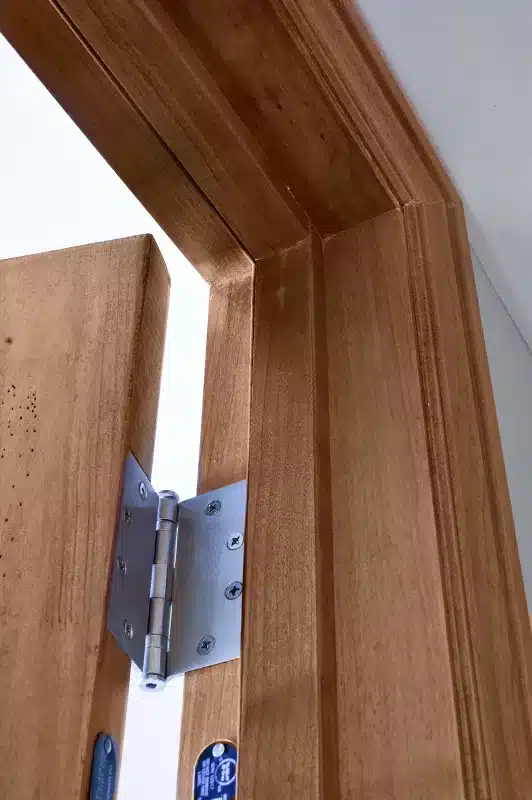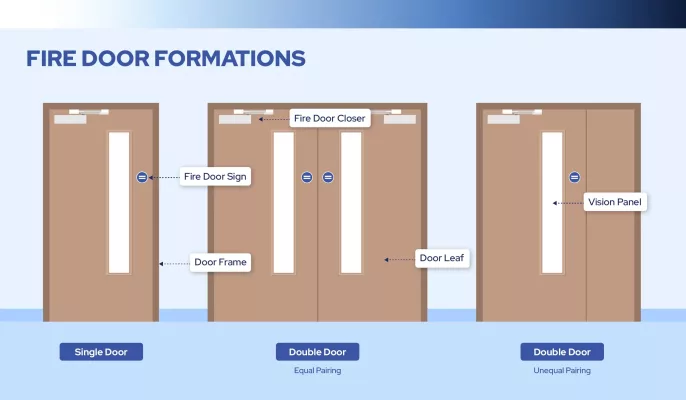Core Installation & Construction FAQ for Fire Doors
1. How do I ensure the fire door frame is square before fixing it to the wall?
A fire door frame must be perfectly square before it is fixed permanently. If the frame twists or leans even a few millimeters, the door leaf will not close smoothly later.

Why this matters:
Once the frame is anchored and the wall is plastered, correction becomes difficult and costly. A misaligned frame is the number one cause of rubbing, uneven gaps, and failed fire inspections.
Practical steps on site:
- Place the frame in the prepared wall opening without fixing.
- Use a spirit level to check vertical alignment on both hinge side and lock side.
- Set temporary wooden shims on the hinge side first.
- Only tighten anchor screws after confirming the top frame is level.
- Check diagonals with a tape measure. If the diagonals are equal, the frame is square.
Common mistake to avoid:
Do not “pull the frame into shape” with screws. Adjust before fixing, not after.
2. Which side should be adjusted first if the fire door leaf is not closing evenly?
The hinge side must always be adjusted first. This is the side that determines the door’s axis and swing line.
Why this matters:
If you adjust the lock side first, the hinge geometry becomes distorted, creating friction and uneven clearance gaps.
Practical steps:
- Loosen hinge screws slightly.
- Insert thin metal or wood shims behind the hinge leaf closest to the problem (usually at the top).
- Re-tighten and check the gap again.
- Only after the hinge side is correct, adjust the lock side to match.
Pro tip:
A 1 mm adjustment at the top hinge can change the bottom gap by up to 3–4 mm. Small movements matter.
3. Why does my fire door rub against the floor after installation?
Most commonly, the floor finish height was not final when the door was installed. Tiles, carpet, epoxy, or raised flooring can add height later.
What to do:
- Measure finished floor level from construction drawings before installation.
- If drawings are unreliable, ask the flooring contractor directly. This saves rework later.
- If the rubbing has already occurred, adjust hinges or closer — do not cut the door leaf.
Common real-case tip:
If construction schedule forces early installation, leave a temporary 5–8 mm extra clearance below the door until flooring is complete.
4. Can I trim the bottom of the door leaf to adjust clearance?
In most cases, no. Fire door cores are engineered in layers. Cutting the bottom edge can expose the core, reduce fire integrity, and invalidate the certification.
Correct approach:
- First check if the frame or hinge alignment is the cause.
- Only trim if the manufacturer’s documentation explicitly allows trimming and specifies the maximum amount (e.g., “up to 3 mm”).
If trimming is allowed:
- Use a straight guide.
- Cut slowly to avoid heat damage.
- Reseal the exposed edge with intumescent fire sealant.
Common mistake:
Contractors cut 10–20 mm off “to make it close quietly”. This immediately cancels fire rating.
5. What is the correct clearance gap around a fire door according to international standards?
Different standards define slightly different tolerances:
| Standard | Typical Gap Around Leaf | Bottom Clearance |
|---|---|---|
| BS / EN (Europe) | 2–4 mm | 3–8 mm depending on threshold |
| UL / NFPA (US) | 1.5–3 mm | Usually 19 mm max without threshold |
| AS (Australia) | 2–4 mm | 3–10 mm |
How to check on site:
Use a gap gauge or thick feeler card, not visual judgment.
6. How tight should the intumescent seals fit into the frame?
They should sit firmly, but not so tight that the door requires force to close.
Why it matters:
- Too loose → smoke leaks in first minutes of a fire.
- Too tight → door closer has to work harder and may fail to latch fully.
Check method:
Run your finger along the strip. It should not pop out or show gaps. If overstretched, replace rather than glue.
7. How can I adjust the door closer to prevent slamming or slow closing?
Every closer has separate valves for closing speed and latching speed.
Steps:
- Identify adjustment screws (usually located under a cap).
- Turn closing speed valve in small increments (1/8 turn at a time).
- Adjust the latching valve only at the final 10–15° of closing swing.
- Test with the door opened fully and halfway. It must latch without force.
Field reminder:
Do not fully unscrew adjustment valves. Oil will leak and the closer is permanently damaged.
8. Is it acceptable to replace fire-rated hinges or closers with local hardware?
No. Hinges, closers, locks, latches, and seals form a tested set. Changing a single part can void certification even if the hardware is also “fire-rated”.
What to do:
- Use hardware listed on the manufacturer’s hardware schedule.
- If substitution is necessary, request a written compatibility confirmation from the door supplier.
9. How do I check if the fire door’s leaf and frame are properly aligned after installation?
A quick pre-inspection routine before formal fire inspection:
Checklist:
- Gaps are consistent (use feeler gauge).
- Leaf closes fully without touching frame edges.
- Latch engages smoothly.
- Seals are continuous.
- Hinges are secure with no visible sag.
- Closer latches within 5 seconds without slamming.
Why this matters:
A door that fails latching fails the fire protection function.
10. What if the wall opening is not perfectly perpendicular or has uneven sides?
This happens frequently on concrete, block, and drywall partitions.
Correct method:
- Always align and shim the hinge side first.
- Shim gradually and evenly, not in one large correction.
- Only after the hinge side is true, align the lock side for correct closure line.
Avoid this common error:
Do not bend the frame to “fit the wall”.
The wall must adapt to the door frame, not the other way around.
Compliance & Inspection FAQ for Overseas Procurement and Engineering Clients
1. How do I verify that the fire door I purchased is truly certified for my country?
Fire door certification is national and regional, not universal. A door tested in one region may not automatically qualify for use in another.
Why this matters:
Even if a fire door is manufactured correctly, using it without correct certification in your jurisdiction may lead to project rejection, failed insurance audits, or legal liability.
What to check before purchase:
- Confirm which standard your project requires:
- UL / NFPA (United States, Middle East)
- BS 476 / EN 1634 (UK, EU, Africa, parts of Asia)
- SABS / SONCAP (South Africa, Nigeria, ECOWAS region)
- AS 1905 (Australia)
- Request the official fire test report from accredited labs (Warringtonfire, Intertek, SGS, TUV, etc.).
- Ask whether the report covers your exact door structure, not just “similar model” or “example product”.
- Verify the certification number on the testing organization’s database—most countries allow direct online verification.
Field tip:
Be cautious when a supplier says, “This certificate is general, it works everywhere.”
There is no universal fire door certificate.
2. Do I need local testing after importing fire doors from China?
In many regions, yes, especially when:
- The project is government-funded.
- The building type is hospital, school, airport, or high-occupancy.
- The country requires local test registration (Brazil, Saudi Arabia, Kenya, Egypt, South Africa, etc.)
How this usually works:
- The imported fire door is tested again in a local accredited lab to confirm compliance under local rules.
- Testing cost is often shared between importer and manufacturer in long-term cooperation.
Real project insight:
Professional Chinese manufacturers already know which African, Middle Eastern, and South American countries require secondary testing, and can design product structure in advance for easier pass rate.
3. What documents should be included with a compliant fire-rated door shipment?
A properly prepared shipment should include:
| Document | Purpose | Notes |
|---|---|---|
| Fire Test Report | Proves fire resistance rating | Must show door structure, hardware, leaf, frame |
| Certificate of Conformity | Legal proof of compliance | Required for most customs clearance |
| Hardware Specification List | Ensures correct component matching | Hinges, closers, locksets, seals |
| Installation Manual | Guides proper fitment to maintain rating | Should include gap tolerances and fixing method |
| Maintenance & Inspection Guide | For long-term building safety compliance | Required for handover and facility audits |
If any of these are missing, inspectors often delay approval.
4. Can the fire door label be removed or replaced during installation?
No.
The certification label is a legal identifier linking the physical door to its fire test documentation.
Why this matters:
Removing or replacing the label immediately voids the certification, even if the door itself is technically correct.
Contractor practice guideline:
- Protect labels with masking film during construction.
- If the label is damaged or scratched, request a replacement directly from the manufacturer with traceability records.
Never print your own labels.
Auditors know exactly what genuine label formats look like.
5. How often should fire doors be inspected after installation?
Fire doors are part of ongoing building fire safety, not a “install once and forget” system.
General international inspection intervals:
- Monthly: Basic operation check (closing, latching, no obstruction).
- Every 6 months: Hardware and seal condition check.
- Annually: Full documented inspection by a certified fire inspector.
What building owners should look for:
- Door must fully close and latch on its own.
- Seals must not be cut, painted over, or missing.
- Closer oil must not be leaking.
- Hinges must not sag.
- No additional locks, chains, wedges, or stops added later.
Common failure cause:
Not the door itself, but post-installation modifications by tenants or facility staff.
6. If hardware is damaged later, can replacement parts be purchased locally?
Only compatible hardware listed in the fire test report may be substituted.
If incorrect hardware is used, the door may fail to latch in fire conditions, causing smoke spread.
Correct approach:
- Request a hardware cross-reference list from the manufacturer.
- If sourcing locally, send photos/spec sheets before installing.
- Keep record of hardware replacement for facility fire safety logs.
7. What happens if a fire inspector finds non-compliant fire doors during final acceptance?
Depending on local law, consequences may include:
- Delay of building handover
- Re-inspection fees
- Forced removal and reinstallation
- Insurance non-coverage in case of fire accident
Prevention:
Perform a self-inspection using the maintenance checklist before formal inspection.
It saves time, negotiation, and potential penalties.
8. Who is responsible for final compliance: the manufacturer or the installer?
Both.
| Phase | Responsibility | Failure Result |
|---|---|---|
| Manufacturing | Ensure certified structure & hardware set | If wrong → product is non-compliant |
| Installation | Maintain gaps, hinges, seals, closer alignment | If wrong → door becomes non-compliant even if certified |
Project Management & Installation Coordination FAQ
1. When should fire doors be installed in the construction timeline?
Fire doors should not be installed too early in the project. If the floor level is not finalized or wet trades (plastering, tiling, screeding) are still ongoing, the door leaf is very likely to be damaged or end up rubbing the finished floor later.
Correct installation sequence:
- Wall openings complete and fully cured.
- Floor finish level confirmed (or verified via elevation drawings).
- Heavy wet work finished (no cement splashes or high humidity).
- Door frame installed first, leaf hung only after surrounding work settles.
Practical field rule:
Install fire doors near the end of finishing stage, not during structural work.
Reason:
The fire door must be treated as a precision element, not a “normal door”.
2. Should fire doors be stored on-site before installation? How to avoid warping?
Yes, fire doors can be stored temporarily on-site, but storage conditions matter.
Correct on-site storage method:
- Keep doors in original packaging for as long as possible.
- Store vertically, leaning slightly at 5–10° against a stable wall — never flat.
- Avoid direct sunlight, moisture, and rapid temperature changes.
- Do not remove protective edge strips until just before installation.
Why warping happens:
Many job sites have uneven humidity. If one side of the leaf absorbs moisture and the other does not, it will warp.
This is not a manufacturing defect — it’s storage handling.
Contractor tip:
Do not store fire doors in freshly plastered rooms. Fresh plaster = high humidity.
3. How do I communicate door schedules and hardware sets with the contractor?
Miscommunication often causes:
- Wrong locks paired with wrong function rooms.
- Frames arriving before openings are ready.
- Door leaves on site with no matching hardware.
To prevent this:
- Freeze a Door Schedule early in the project.
- Assign each door a unique ID (D01, D02…) tied to drawings.
- Use a Hardware Set Table that matches each door ID to its hardware:
- Lever lock / panic bar / mortise / magnetic lock
- Number of hinges
- Closer model
- Seal specification
- Confirm who provides what:
- Door manufacturer?
- Local hardware supplier?
- General contractor?
Golden rule:
Hardware should be finalized before production, not when the door arrives on site.
4. What is the most common installation mistake that leads to failed fire inspection?
It is not usually the door itself.
The most common failure is incorrect gap control and non-compatible hardware installation.
Signs inspectors look for:
- Gaps wider than standard (especially near top corner).
- Seals missing, painted over, or cut short.
- Door does not latch automatically.
- Hinges replaced with non-rated versions.
- Bottom gap too large due to incorrect floor level prediction.
Key insight:
A certified fire door becomes non-compliant the moment it cannot self-latch.
A door that doesn’t latch means smoke spreads through corridors — which is the real hazard.
5. Who is responsible for final fire door compliance: manufacturer or installer?
Both, and failing either side means the door is considered not fire-safe.
| Stage | Responsibility | Risk if performed incorrectly |
|---|---|---|
| Manufacturer | Provide certified door leaf, frame, seals, hardware set | Product invalid if uncertified or mismatched |
| Installer | Maintain tolerances, correct alignment, correct hardware assembly | Certified door becomes non-compliant |
Misunderstanding that causes project disputes:
Many contractors assume, “The door came certified, so once I install it, it must be compliant.”
This is incorrect.
Correct understanding:
- Certification verifies the product,
- Installation verifies the performance.
If the installation is wrong, the certification no longer applies, even if the door is perfect.


